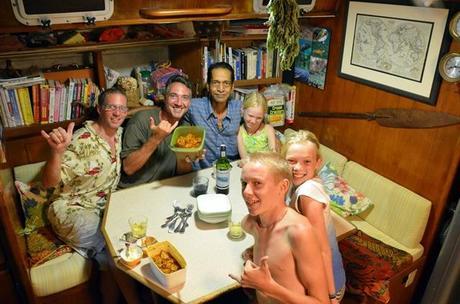 Ponnusamy, or Sam as we call him, prepared chicken curry at his home in Penang, Malaysia for us to share on Totem recently. He called it “a simple curry” although was anything but simple, with so many different spices that even chili-fueled fire didn’t overwhelm the complex flavors. Other than love of good chicken vindaloo it would be easy to assume we don’t have much in common with Sam, yet over the course of a few evenings together he’s become a good friend. Different paths, cultures, beliefs, and we are richer for our time together.
Ponnusamy, or Sam as we call him, prepared chicken curry at his home in Penang, Malaysia for us to share on Totem recently. He called it “a simple curry” although was anything but simple, with so many different spices that even chili-fueled fire didn’t overwhelm the complex flavors. Other than love of good chicken vindaloo it would be easy to assume we don’t have much in common with Sam, yet over the course of a few evenings together he’s become a good friend. Different paths, cultures, beliefs, and we are richer for our time together.
We’ve made precious few friends like Sam during this last year in Malaysia and Thailand. That makes the cruising life sound lonely, which is misleading. True, going cruising will affect the friends in your life. It almost certainly thins the ranks of your current circle. But unless you choose solitude, new friends are everywhere: in the countries you visit, and the vessels nearby.
Friends at home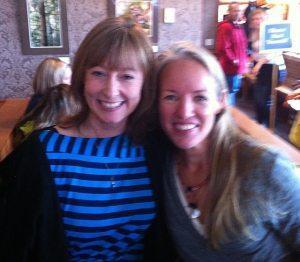

The transition into cruising is the hardest period, as existing relationships shift and what lies ahead is less certain. Some friends, or even family, may not support your dream at all. By choosing a different path, they may feel you’ve passed judgment on their choices, and react defensively. We’ve met cruisers who were cut off by those who felt abandoned or rejected after they set sail. You have to ask yourself: if someone cannot be happy for you to following you dream, is that relationship really a friendship? For friendships that drift away, in most cases, it’s not a deliberate act but the inertia from simply not being physically present. But for friendships based on deeper connections than living down the street or having your kids in the same class, technology makes it possible to stay connected. I’m not great about staying in touch, but there are friendships at home that are stronger in my heart as the distance makes them sweet.
Friends afloat
We were introduced to the sped-up nature of cruising friendships even before we escaped the border to Mexico. Pulling into the harbor in Monterey, California, a child called to us from the dock: “hey Totem! I know you!” We, on the other hand, had absolutely no idea who the kid was. It turned out Bear and his family learned through the coconut telegraph that another cruising family was headed their way, so they were on the lookout. We became fast friends, and later shared scores of anchorages across thousands of miles.
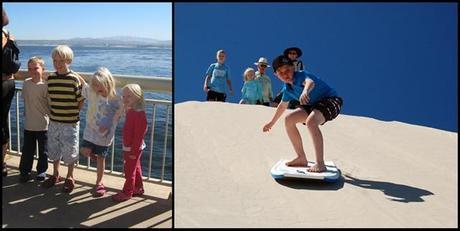
Our very first meeting with Bear, in 2008… and on the sand dunes of Australia in 2012.
In Langkawi last month we met an adventurous German family, freshly living aboard with zero boating experience. They have many questions and we’re happy to help. Then there’s the Russian / Australian couple from across the anchorage who regaled us with stories of land travels to over 70 countries. And the 82 year old Welsh single-hander a few boatlengths ahead: he’s circumnavigated three times! Meeting people while cruising is easy. Maybe it’s because everyone has an accent and “where are you from” is an easy ice-breaker. Or maybe it’s because when you park you house (boat) in someone’s yard, they want to know who the new neighbor is. Or perhaps, in cruising the world we left some artificial constraints behind. Sometimes we are the biggest boat around – or smallest, most experienced – or least, funniest – or not. It doesn’t matter when you’re in the same anchorage. Our differences don’t keep us apart. Instead they are part of why we are all living this lifestyle.
It’s typical in many popular cruising areas for vessels to ebb and flow along similar routes based on seasonal weather. Meet a new cruising friend in one harbor, and whether by accident or intention, it’s easy to meet again in a new port. Sometimes we choose to be on our own but it’s often the company of familiar yachts we keep, falling into the pattern of “bungee boating” (our term for loose buddy boating, as distances between our boats stretch and spring back).
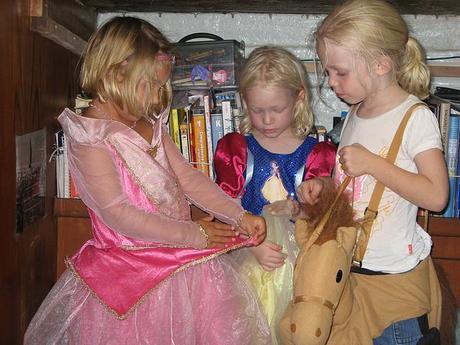
the girls play “dress-up” with a new friend in Mexico: December, 2008
If anything, it’s goodbyes that are the difficult part. Jamie and I have joked that cruising is like dog years for marriages (one year equals seven years): you spend so much time together, and in more intense living than typical land life. Friendships are similar, and close friendships form comparatively quickly. An experienced cruiser who was one of my first friends after cutting the docklines helped prep me for the roller coaster of parting ways, although I was too new to appreciate it at the time. It still stinks to say goodbye after making a great connection with a new friend, but having been able to also say “hello!” again to so many boats we parted ways with – it always feels possible, even likely, we’ll meet again.
Last year, we enjoyed several months with a family we originally met in Mexico more than five years ago. In December, we have a much-anticipated reunion with a Canadian cruising family we spent time with in both Mexico and Australia. Those are just two of many examples this last year, as we’ve reconnected with a surprising number of boats previously met in different countries and across a wide range of longitudes.
Local friends
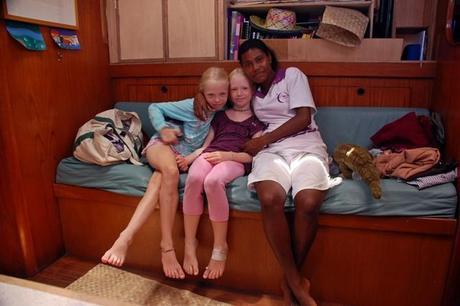
the girls with Mollina, their auntie in Ninigo
In the slower pace of less developed countries, we’re more likely to make lasting friendships with people ashore. Village life has a different rhythm, and people are more likely have the time and the interest to pause in their day for conversation. Simply asking for directions may be the spark that starts a series of exchanges and contact over time. Although our stay in a given locale may be relatively brief, but where people have time to give, that can be enough.
In Ninigo, Papua New Guinea, days were both languid and packed. Adopted by a family, we passed hours sharing stories. This was done in parallel with other activities: a walk to the vegetable garden for dinner, an afternoon under palms weaving baskets, a jaunt to the reef to spear fish, a trip across the lagoon in a sailing canoe. We were only there about one week, but we left, we were told: “You must change your citizenship. You are from Ninigo now!” In the two years since, we continue to trade messages whenever a passing boat can play intermediary, and children in Ninigo are named after ours.
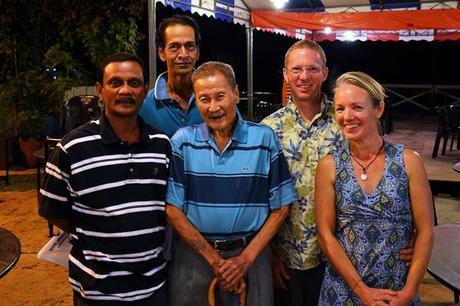
Dinner in Penang with Thana, Sam, and Mr Ong – “the chemical man.”
Here in Malaysia, it’s been more difficult. There’s a thriving middle class: people have 9-5 jobs and family cars and schedules. There is simply less opportunity to connect as locals rush around keeping up with their busy lives. It’s easy to empathize since our patterns were the same before we went cruising. If I met a traveler that needed directions, I’d help just as I’m often helped here, but it’s unlikely that the interaction would extend farther. This is what made our curry dinner and other nights out in Penang with Sam particularly sweet: after nearly a year in Malaysia, making Malaysian friends felt like a breakthrough.
Some sail away to escape, but for us it’s all about the friends we make while cruising. Our lives are immeasurably richer for what we have learned and shared with the people we’ve met along the way. It can be difficult to take the leap, but remember: as far as friendship are concerned, cruising wrecks your life for the better, and you should never pass up an offer for a simple curry.
Jamie and I co-author the cruising column for 48° North, a Pacific Northwest boating magazine. Friendships have been on my mind a lot lately, with the loss of a special friend at home and the distance between others set to increase as we point west. You can read the full issue for free, online, or pick up a copy on newsstands around the Salish Sea.
As always, we appreciate it when you read this on the Sailfeed website!

